After viewing the Vatican Museum and the Sistine Chapel, I was pretty sure we were done being amazing and impressed.
We passed several sarcophagi of popes.
After passing the sarcophagi, architecture began to get more elaborate again. We were entering St. Peter's Basilica. It is the most renowned work of Renaissance architecture, and on of the holiest of Catholic shrines.
The upper figure is St Angela Merici, Italian educator of girls. The lower figure is St Juliana Falconier, by Campi, 1740. Juliana was the foundress of the 1304 Religious Sisters of the Third Order of Servites, known for their care of the sick as well as other acts of mercy.
St Longinues, the Roman soldier who pierced the side of Christ as He was hanging on the cross. His name does not appear in the Bible, but is found in other books of the time.
The is a baldacchino, located over the high altar. It was created by Bernini in 1634. The columns are 66 feet high. It is intended to memorialize the St Peter's tomb, located under the basilica.
It is a bronze structure which combines sculpture and architecture.
The bronze used in this structure is believed to have come from the roof of the Pantheon.
The top has four twice-size angels.
Angel close-up.
Bernini also created the golden Altar of the Chair, enclosing the wooden throne of Peter.
The stained glass window is divided into twelve sections to honor the 12 apostles, with the dove signifying the Holy Ghost.
As a work of architecture, it is considered to be the greatest building of its age.
St Andrew, brother of Jesus, by Francois Duquesnoy, 1635 who was believed to have been crucified on a cross in the shape of an "X".
St. Peter's interior is decorated with gilding, marble, reliefs, sculptures and architectural details.
[St. Peter's is] "an ornament of the earth ... the sublime of the beautiful" -Ralph Waldo Emerson.
The statue hiding to the left of the lovely marble walls is St Norbert, by Pietro Bracci, 1767
Monument to Pius VIII by Pietro Tenerani,1866
The funerary monument of Gregorio Chiaramonti, pope from 1800 to 1823 (as Pius VIII), by Bertel Torvaldsen, 1831
Altar of the Sacred Heart by Carlo Mucioli, 1923
Domes of St Peter's.
It was impossible to get a great shot of the top of the main dome.
The dome is the tallest dome in the world.
There are a number of smaller domes.
These domes are probably better described as copulas.
I really like this fresco dome.
Michelangelo was the artist of this dome.
A couple of unknown statues.
At least *I don't know them.
A team of six artists took nine years to execute the mosaic, finishing in 1767
This is a mosaic, a reproduction of Raphael's "deathbed" painting. It took 6 artists 9 years to complete, finishing in 1767. Napoleon took it to Paris in 1797, and it was returned to the Vatican in 1815.
Just collecting some "remodel my house" ideas...
St. John Bosco, priest, educator, and writer of the 19th century.
By Pietro Canonica, 1936
By Pietro Canonica, 1936
Marble floors of the basilica.
The Basilica is a teensy 240,000 square feet. It is the world's largest Basilica.
it is 448 feet high, 730 feet long, 500 feet wide.
The Basilica holds 60,000 people.
The phrase on top "In hoc vinces" translates to "In this, you will conquer". This is a reference to a vision/dream of Constantine, telling him he would defeat his enemies using the sign of the cross.
To date there have been 266 popes.
Maria Clementina Sobieski, Catholic Queen of England, Scotland, and Ireland who lived in Rome at the invitation of the Pope. She is buried in the Basilica.
I noticed a crowd gathered in one area of the Basilica, so I went to investigate.
I was shocked to see the Pieta by Michelangleo Buonarroti. It took two years to create and was finished in 1499. It is the only work Buonarroti ever signed.
I don't know where I thought this work was located, but I didn't expect to see it here.
It was heavily damaged in 1972 when a mentally ill man attacked it with a hammer. After it was restored, it was permanently placed behind a bullet-proof glass.
It is so tender, so beautiful, I got down right teary.
One of many representations of Peter.
Mosaic by Pietro Paolo Christofari, 1755. Beneath the mosaic is the altar of St. Sebastian, an early Christian martyr from the Late Roman Empire. Under the altar are the remains of Pope St John Paul II, which were moved to the chapel in 2011.
Countess Matilda of Tuscany, by Bernini, 1637. She lived from 1046-1115 and was a strong military and firm supporter of Pope Gregory II.

I was disturbed to see an entombed pope. Eww. Our guide assured us it was merely a wax figure. Phew. Then I got home I did some reading. It's actually the body of Pope John XXIII, covered in a layer of wax to prevent decomposition. Eww. Pope John XXIII has been on displayed since his death in 1963.
Marble altar.
Swiss guards have been protecting the Pope since 1506. At that time, Switzerland was a poor country, and the Vatican position paid well. They have to be Catholic, unmarried, already completed Swiss military service, between 19-30 years old, and at least 5' 8".
Those spiffy uniforms have been in use since 1506. They are a common style of the Renaissance Era, the time when their service began.
The exterior of St Peter's was designed and executed by Michelangelo.
The building is topped with the statues of 140 saints of the Catholic church. The chairs are set up because later today the Pope will be addressing the crowd.
The Vatican is visited by around 25,000 people a day on average. Even in the rain.
Closer view of the Basilica.
Water fountain, built by Bernini in 1677.
Fountain and obelisk. The obelisk is a 4000 year old Egyptian creation, brought to Rome in 37 AD. It was placed in its current spot, very near to its original placement in the 1500's when it was acquired by the Pope.
Looking toward the Basilica dome.
The dome is tall enough to be spotted from many places in Rome.
This monument to St. Catharina was placed here in 1961. She lived from 1347-1380 and is famous for convincing the Pope of her day to move the Vatican from France to Spain.
As we left the Vatican, I thought, "What a great day! What a prefect end to a fabulous trip!"
Little did I know the best was yet to come.



















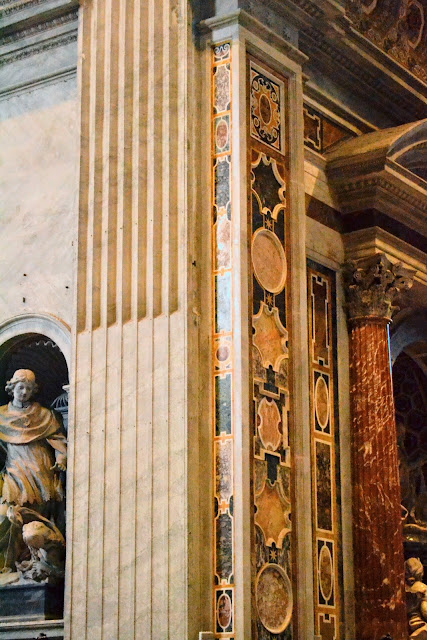































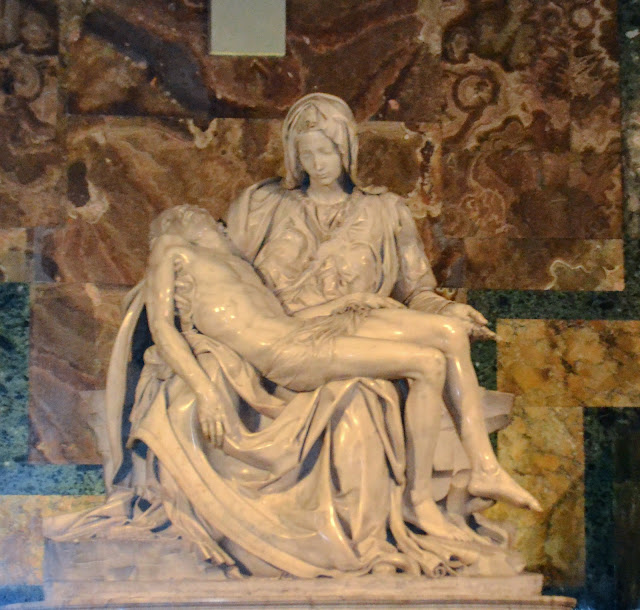






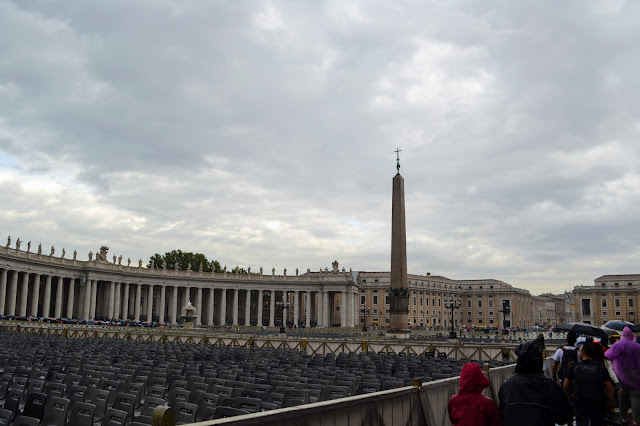

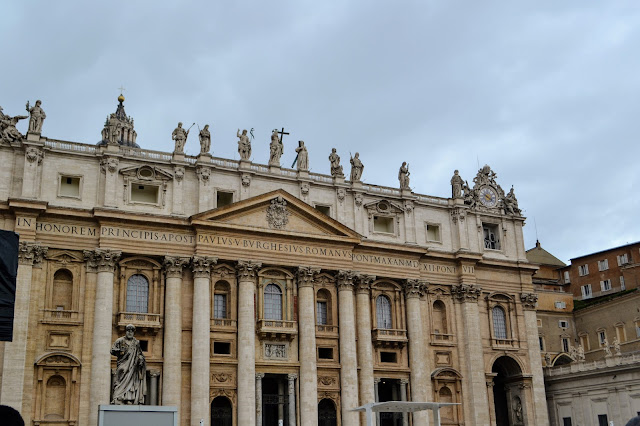
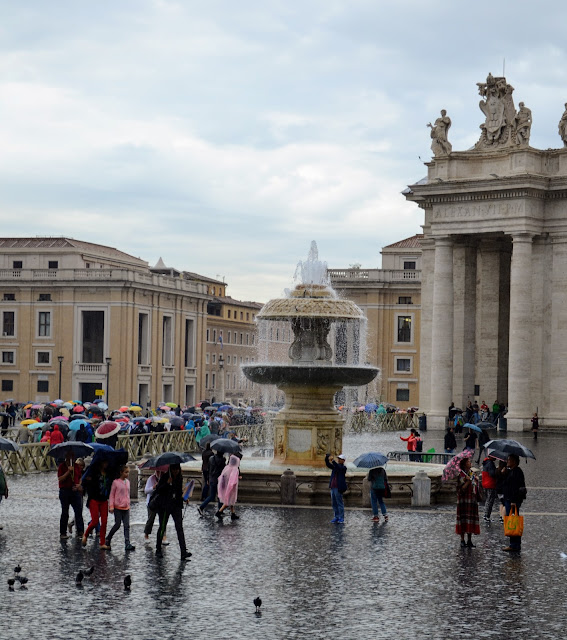





I remember coming upon the Pieta in St. Peter's and also getting very emotional. I don't think any other sculpture has affected me as strongly. There is something about the looseness of Christ's body and the tenderness of Mary that just isn't captured by photos or reproductions. That is my favorite piece of art in Rome.
ReplyDeleteSt. Peter's is pure eye candy. Between Michelangelo and Bernini, you can't get any better sculpture - and to have them both in the same place. Fun to go through the interior and exterior.
ReplyDelete